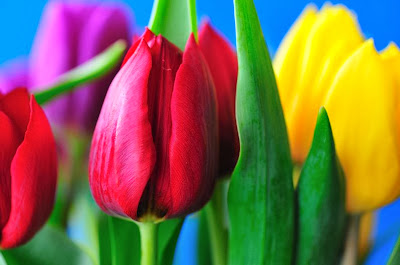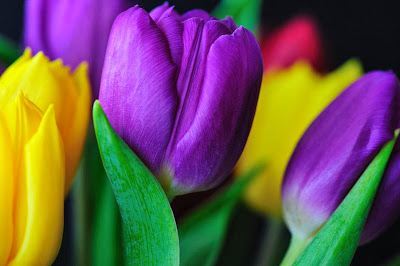Type of Flower
Tulip
The tulip is a perennial, bulbous plant with showy flowers in the genus Tulipa, of which around 75 wild species are currently accepted and which belongs to the family Liliaceae. The genus's native range extends west to the Iberian Peninsula, through North Africa to Greece, the Balkans, Turkey, throughout the Levant (Syria, Israel, Lebanon, Jordan) and Iran, North to the Ukraine, southern Siberia and Mongolia, and east to the Northwest of China.The tulip's centre of diversity is in the Pamir, Hindu Kush, and Tien Shan mountains.It is a typical element of steppe and winter-rain Mediterranean vegetation. A number of species and many hybrid cultivars are grown in gardens, as potted plants, or to be displayed as fresh-cut flowers. Tulip cultivars have usually several species in their direct background, but most have been derived from Tulipa suaveolens, often erroneously listed as Tulipa schrenkii. Tulipa gesneriana is in itself an early hybrid of complex origin and is not the same taxon as was described by Conrad Gesner in the 16th century.





Tulips are spring-blooming perennials that grow from bulbs. Depending on the species, tulip plants can grow as short as 4 inches (10 cm) or as high as 28 inches (71 cm). The tulip's large flowers usually bloom on scapes or subscapose[further explanation needed] stems that lack bracts. Most tulips produce only one flower per stem, but a few species bear multiple flowers on their scapes (e.g. Tulipa turkestanica). The showy, generally cup or star-shaped tulip flower has three petals and three sepals, which are often termed tepals because they are nearly identical. These six tepals are often marked on the interior surface near the bases with darker colorings. Tulip flowers come in a wide variety of colors, except pure blue (several tulips with "blue" in the name have a faint violet hue).
Tip of a tulip stamen. Note the grains of pollen
The flowers have six distinct, basifixed stamens with filaments shorter than the tepals. Each stigma of the flower has three distinct lobes, and the ovaries are superior, with three chambers.[further explanation needed] The tulip's fruit is a capsule with a leathery covering and an ellipsoid to subglobose shape.[further explanation needed] Each capsule contains numerous flat, disc-shaped seeds in two rows per chamber.These light to dark brown seeds have very thin seed coats and endosperm that does not normally fill the entire seed.
Tulip stems have few leaves, with larger species tending to have multiple leaves. Plants typically have 2 to 6 leaves, with some species having up to 12. The tulip's leaf is strap-shaped, with a waxy coating, and leaves are alternately arranged on the stem; these fleshy blades are often bluish green in color.





Although tulips are often associated with the Netherlands, commercial cultivation of the flower began in early Persia probably somewhere in the 10th century. Early cultivars must have emerged from hybridisation in gardens from wild collected plants, which were then favoured, possibly due to flower size or growth vigour. During the Ottoman Empire, numerous tulips were cultivated and bred. Tulips are called lale (from Persian لاله, lâleh) in Farsi, Turkish, Arabic, Macedonian and Bulgarian are written with the same letters as Allah, which is why the flower became a holy symbol. It was also associated with the House of Osman, resulting in tulips being widely used in decorative motifs on tiles, mosques, fabrics, crockery, etc.The word tulip, which earlier appeared in English in forms such as tulipa or tulipant, entered the language by way of French: tulipe and its obsolete form tulipan or by way of Modern Latin tulīpa, from Ottoman Turkish tülbend ("muslin" or "gauze"), and is ultimately derived from the Persian: دلبند delband ("Turban"), this name being applied because of a perceived resemblance of the shape of a tulip flower to that of a turban. This may have been due to a translation error in early times, when it was fashion in the Ottoman Empire to wear tulips on their turbans. The translator possibly confused the flower for the turban.









References and more ...http://en.wikipedia.org/wiki/Tulip
Picturs..http://www.flickr.com/
.jpg)



.jpg)
.jpg)
.jpg)
.jpg)
.jpg)
.jpg)
.jpg)
.jpg)
.jpg)

.jpg)
.jpg)
.jpg)
%2BRhanterium.jpg)

.jpg)
.jpg)
.jpg)
.jpg)
.jpg)
.jpg)

















